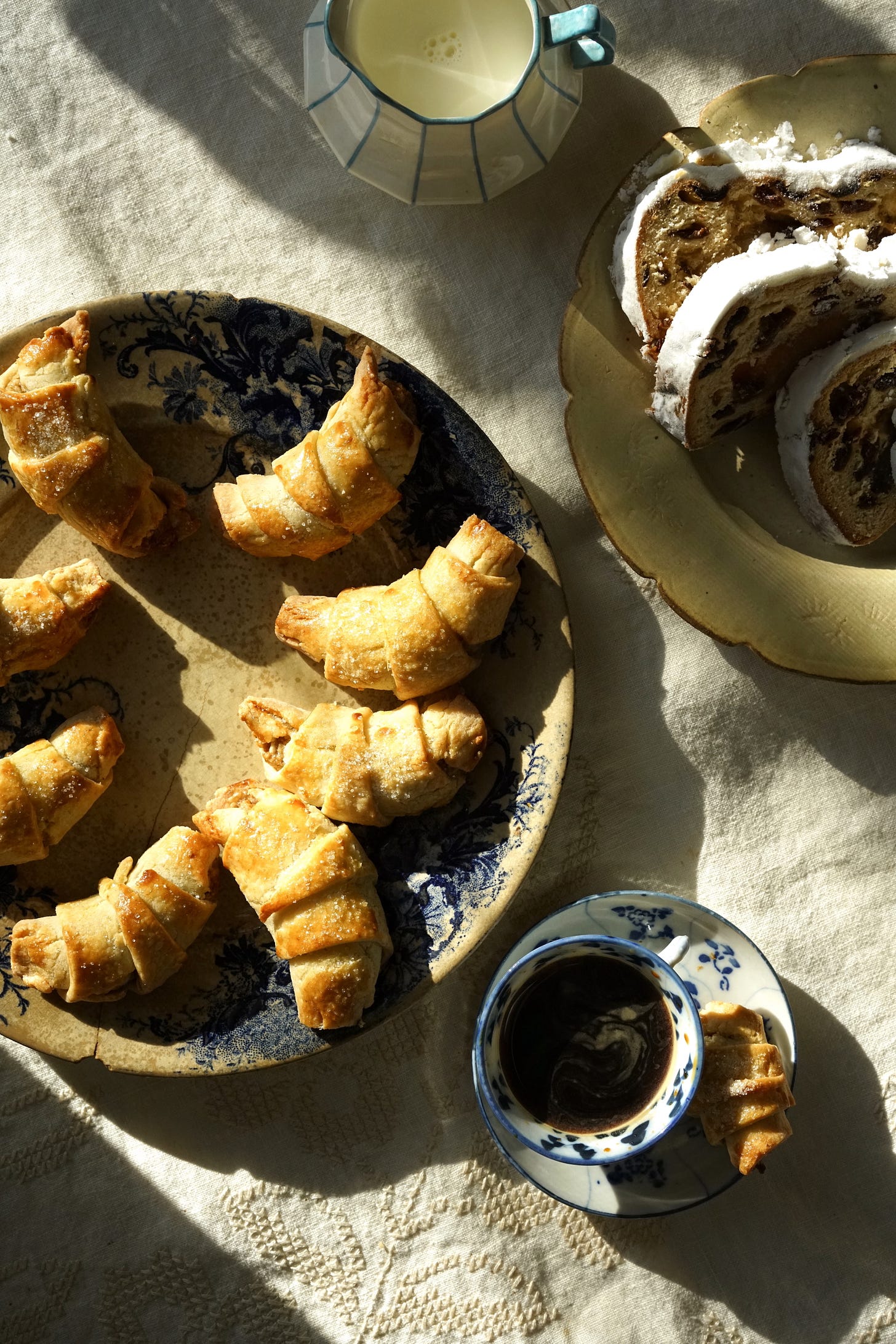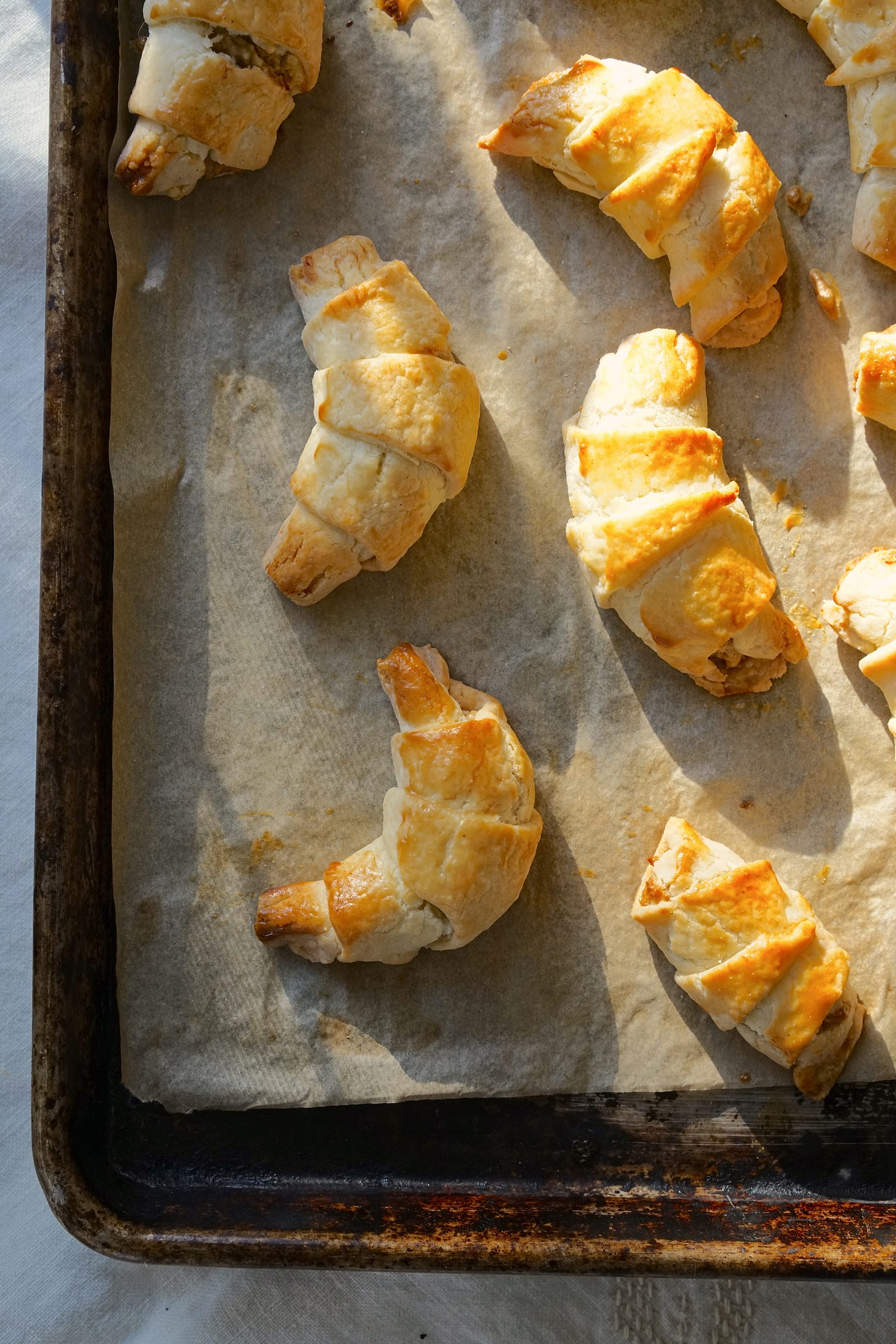HUNGARIAN CHRISTMAS
Strudel, Stollen, and Kifli—Hungary's beloved Christmas cookie (a recipe, and some history). Musings on finding Hungary, back home.
Hello!
Happy December, and the third week of advent. Like so many families, our days are marked by a morning peek into the advent calendar, daily chocolates, festive gatherings, and stockings dangling— a beacon of the glitter still to come.
But for us, this has also been a time of transition—getting the kids settled into their old (but new-feeling) schools—in new grades, new teachers, and new wings of the school since they left, last June. It is a feat that has taken all of me, my whole heart and soul. I’ve tried to stay present for every emotion, and face every challenge head-on—little people finding their footing again.
I’ve described these last three weeks back in America to friends as a big adjustment for the kids, but for me: just jumping back into our old life—plus, Christmas.
Partly, it’s true. But in some ways, I’m also mourning a loss. The loss of our daily rhythms in Hungary. A loss of certain freedoms and adventure. Of access to worlds beyond our life in New York. The challenge of the language. Of slow Sundays with my friend Eszter and her stunning mares, Szelíd and Buba. Weekly rides across dewy, mushroom-dotted plains. The gentle care of Nagymama, and her endless pots of soup. Nagypapa’s laugh. Lace curtains, good wine, and waking up to the roosters.
As always, when we want to conjure Hungary, we cook our way back. We make bableves and light candles at dinner, as we do at Kis Madar Haz. And, more and more, I lean into the traditions of my husband’s childhood—what his advent would have looked like—as much as repeating my own.
Last Monday, like most young Hungarians (and children all over Europe), Greta and Mátyás put their shoes in the window, for Mikulás (St. Nicholas) to leave them treasures—a tradition I didn’t pick up until Greta was about 3. Unlike Santa, the patron saint of shiny new toys found on Christmas morn, Mikulás fills our shoes with chocolates and Christmas candies, vintage treasures, metal cookie cutters, hand-blown ornaments, and a little something for mama—a tiny ceramic pitcher with blue trim or tarnished brass candlesticks.
My kids know to expect something small but significant. Something that speaks of another time, of the slow and hand-made.
The next morning, we sliced into our Dresden Stollen, the sugar-dusted Christmas bread from Germany András and I both grew up with, with its distinctive marzipan middle. By midweek, I was working away at Dios Kifli–Hungary’s beloved Christmas cookie–flaky and crescent-shaped, which holds parcels of sweetened ground walnut inside.
All week I worked slowly on batches of kifli, rising early when my children lay, still sleeping, by the glow of the tree. Kifli aren’t difficult, but you can stretch out and nurture them if you wish—making the dough one night after dinner, rolling them in the long shadows of the late afternoon, baking them hot and fresh, before you slip to your pal’s house for a Christmas sleepover, as we did this weekend.
Kifli appreciate your care, and you’ll taste it.
By Thursday, Andras arrived home from the city with a box of strudel under his arm. The kids rush to unwrap it, delighted. In a world of abundance (American Christmas, all glitz and shimmer), I’m thrilled a brown box tied with string can still elicit joy — a connection to a time when a Papa’s treasure from the bakery was everything.
I write to check in on Eszter; Sundays aren’t the same here, I say.
“Don’t be sorry,” she replies. “The long fogs of winter are coming.”
She’s right, as she always is.
We’re where we need to be, for now. In the meantime, we circle the kitchen, rolling and filling. Watching through the oven window for that gentle, golden brown. It’s how I’ve always known how to love my family—to give András home, when he longs for it.
You’ll find my recipe and lots of notes about kifli—below. They’re similar to cookies you’ll find in Austria, Romania, Slovenia, Ukraine, Poland, Isreal, and beyond—perhaps, even, a place you’re longing for. They really are wonderful—not too sweet, like all the best of Hungarian süti (pastry), and right at home in a cookie tin.
Happy baking loves. May you find your way back to your favorite places this season.
Xo
Sarah
This is a reader-supported publication. If you’ve found your way here by accident, welcome! You can subscribe below. And, if you find value in your weekly drop-in, now is a great time to go paid—there’s lots of great paid content coming! Other ways to support my work: buy my books, like this post, and forward it to a friend.
HUNGARIAN WALNUT KIFLI (Walnut Crescent Cookies)












